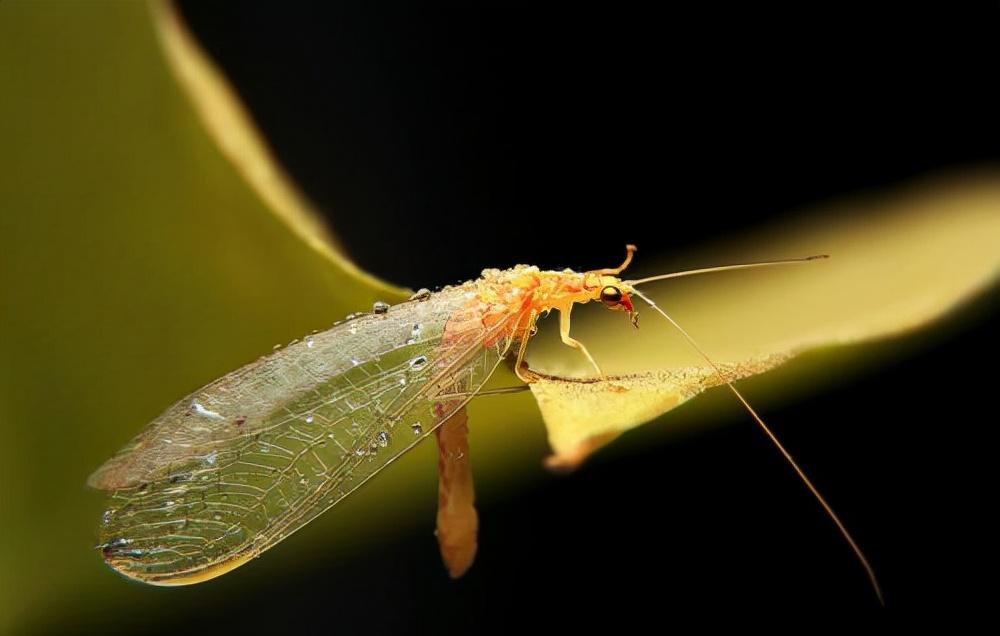In midsummer, when you travel the mountains, you can often see insects with four huge, transparent, tulle-like wings flying slowly in the air. When they stop on flowers or blades of grass, they can be observed to grow particularly elegant and beautiful - these insects have a slender green or light yellow body, transparent wings that protect the body like a skirt, these wings usually have a mesh pattern, sometimes even golden yellow wings.

At first glance, you always think of them as a bit like small dragonflies, but on closer inspection, it is not difficult to see that there are many differences between them and dragonflies: First, dragonflies have very small bristle-like antennae, which are almost invisible if they are not close, but they usually have very long antennae. These two pea-like antennae are sometimes filamentous, sometimes sticky, and sometimes even slightly inflated at the top, like the tentacles of a butterfly. Second, when dragonflies stop, their wings stretch horizontally to the sides of their bodies, while their wings fold backwards and cover their bodies. In addition, dragonflies are active during the day, but they often appear in the lights at night.
You encounter the worms among carnivorous insects. In fact, the insects are collectively known as phyllodera, serpentines, broad-winged, and long-winged insects. Although the species are few, they are widely distributed.
<h1 class="pgc-h-arrow-right" data-track="4" > grasshopper: "wolf in sheep's clothing"</h1>
Grasshoppers are predatory insects. There are 1350 species in 86 genera in the world, and 100 species in 15 genera in China. They are widely distributed in China, and the common ones are Licao, Asian and African grasshopper, yellow brown grassfly, common grasshopper and so on. Despite their weak appearance, grasshoppers are ferocious predators of aphids such as cotton aphids, wheat aphids, bean aphids, peach aphids, apple aphids, etc.
Female grasshoppers prefer to lay eggs on dense branches of aphids so that their larvae can prey nearby as soon as they hatch. The appearance of grasshopper eggs is unique among insects. Most grasshopper eggs have slender silk stalks that look like "lollipops." The base is fixed to a branch or leaf, but the egg hangs high on top of a silk handle and is more than 10 mm long.
Some scientists believe that this elaborate egg should be designed to avoid trampling by aphid swarms and effectively prevent the invasion of ladybirds and other carnivorous insects. You might think that while one or two aphids are nothing, if a large number of aphids crawl on their eggs all day long and discharge something dirty from time to time, they will get the eggs dirty. There are also ladybugs that feed on aphids all day long and ants that wait for aphids to rain. They may treat these eggs "as a snack, so care must be taken to protect them." The distribution of grasshopper eggs varies due to different species. Dozens of grasshopper eggs are arranged together, some produced individually and some in bunches.
This particular method of spawning is also very special. Female grasshoppers first secrete a little mucus with the tip of their tails, point to the surface of branches and leaves, then tilt their tails, are pulled into filaments, dried to become slender stalks, and then lay eggs at the top of the stalk. The long filamentous stalks are connected to one egg after another, without overlapping each other. These seem to float in the air. The light green or white eggs will hatch within a few days. The newly hatched larvae are almost colorless. They climb up the eggshell and shake in the breeze. After their limbs hardened in the air, they rested for an hour or two, turning into strong and flexible larvae, skillfully sliding down the slender silk stalk and beginning the life of a predator.
Female grasshopper adults lay their eggs in places where aphids congregate. Once the larvae hatch, they can immediately hunt nearby. Known as the "aphid lion", the sand fly larvae have straw-like mouthparts and well-developed feet. They feed on aphids and other soft insects and feed on their liquids. They are very fierce. Its prey weapon is the upper and lower jaws in front of the head. Whenever it finds a target, it opens its upper and lower jaws and clamps it tightly on the target. There are grooves in the upper and lower jaws that allow digestive juices to flow into the hunting object. Fluids that dissolve the body of the prey flow into the prey along the grooves in the chin. The body tissues of the prey will be dissolved, and the dissolved liquid will be immediately sucked into the stomach by the aphid lion. In this way, the shell of the aphid is empty.
If there happen to be no or no aphids around, these ferocious larvae that do not know each other will immediately join the battle of killing each other. At first I thought they were driven by starvation, but then scientists discovered that whenever two larvae meet, they will attack each other without hesitation, no matter what the situation. It seems that this is indeed a ferocious insect. A single grasshopper larvae can suck dozens of aphids a day. Interestingly, these species of grasshopper larvae prefer hollow aphid shells on their backs. Why? Maybe this is the "wolf in sheep's clothing."